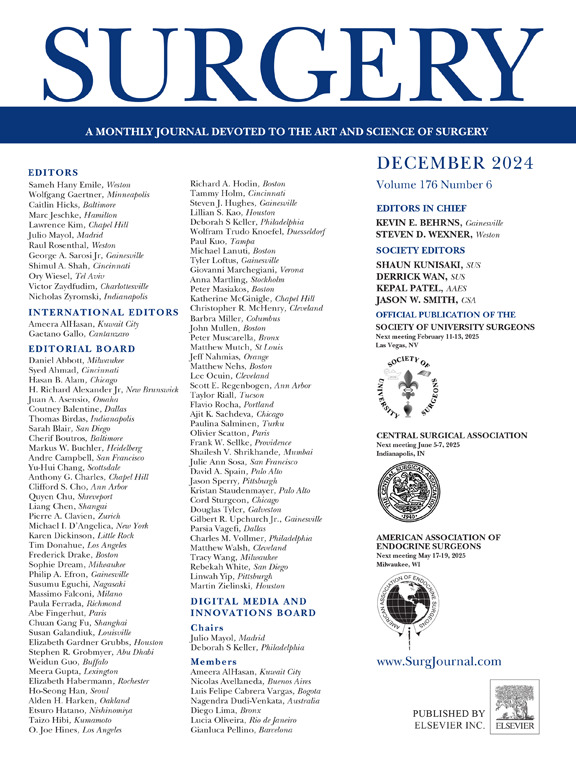腹股沟疝修补术后女性患者的预后比男性患者差吗?腹部核心健康质量协作数据库分析
IF 3.2
2区 医学
Q1 SURGERY
引用次数: 0
摘要
腹股沟疝修补术是最常见的普通外科手术之一。一些证据表明,女性患者术后慢性疼痛和疝气复发的风险更大。我们使用腹部核心健康质量协作数据库调查了男性和女性患者腹股沟疝修复后慢性腹股沟疼痛和复发率。方法对接受选择性单侧腹股沟疝修补术的患者进行腹部核心健康质量协作数据库的查询,这些患者完成了30天的临床随访、基线和1年的欧洲腹壁疝登记调查。包括开放性和微创性病例。本研究的主要结果是1年欧洲腹壁疝登记调查疼痛、限制和美容评分。次要结果为疝气复发。结果共发现1582例患者,其中男性1448例,女性134例。一年的欧洲腹壁疝登记调查和欧洲腹壁疝登记调查的疼痛评分在女性患者中更差(P <;.01和P = .02)。在多变量回归分析中,女性与更严重的疼痛相关(调整效应量,0.77;95%置信区间,0.17-1.37,P = 0.01),限制(调整效应量,1.66;95%置信区间,0.76-2.56,P <;.01)和美容评分(调整效应量0.74;95%置信区间0.18-1.29,P <;.01)。在1年随访中,女性患者的疝复发率更高(校正优势比,2.20;95%置信区间,1.10-4.41,P = .03)。结论本研究表明,尽管微创修补术更普遍,但女性患者的生活质量和疝复发明显较差。确定这些差异的结果是实现腹股沟疝修补健康公平的第一步。本文章由计算机程序翻译,如有差异,请以英文原文为准。
Do female patients experience worse outcomes than male patients after inguinal hernia repair? An analysis of the Abdominal Core Health Quality Collaborative database
Background
Inguinal hernia repair is one of the most common general surgery operations. Some evidence suggests that female patients are at greater risk of chronic postoperative pain and hernia recurrence. We investigated rates of chronic inguinal pain and recurrence after inguinal hernia repair in both male and female patients using the Abdominal Core Health Quality Collaborative database.
Methods
The Abdominal Core Health Quality Collaborative database was queried for patients undergoing elective, unilateral inguinal hernia repair who completed 30-day clinical follow-up and baseline and 1-year European Registry for Abdominal Wall Hernias Survey surveys. Both open and minimally invasive cases were included. The primary outcomes of this study were 1-year European Registry for Abdominal Wall Hernias Survey pain, restrictions, and cosmesis scores. The secondary outcome was hernia recurrence.
Results
The search identified 1,582 total patients, 1,448 male and 134 female. One-year overall European Registry for Abdominal Wall Hernias Survey and European Registry for Abdominal Wall Hernias Survey pain scores were worse in female patients (P < .01 and P = .02, respectively). On multivariable regression analysis, female sex was associated with worse pain (adjusted effect size, 0.77; 95% confidence interval, 0.17–1.37, P = .01), restriction (adjusted effect size, 1.66; 95% confidence interval, 0.76–2.56, P < .01), and cosmesis scores (adjusted effect size, 0.74;95% confidence interval, 0.18–1.29, P < .01) compared with male sex. Hernia recurrence rates were greater in female patients at 1-year follow-up (adjusted odds ratio, 2.20; 95% confidence interval, 1.10–4.41, P = .03).
Conclusion
This study demonstrates that quality of life and hernia recurrence are strikingly worse for female patients, despite a greater prevalence of minimally invasive repairs. Identification of these disparities in outcomes is the first step toward achieving health equity in inguinal hernia repair.
求助全文
通过发布文献求助,成功后即可免费获取论文全文。
去求助
来源期刊

Surgery
医学-外科
CiteScore
5.40
自引率
5.30%
发文量
687
审稿时长
64 days
期刊介绍:
For 66 years, Surgery has published practical, authoritative information about procedures, clinical advances, and major trends shaping general surgery. Each issue features original scientific contributions and clinical reports. Peer-reviewed articles cover topics in oncology, trauma, gastrointestinal, vascular, and transplantation surgery. The journal also publishes papers from the meetings of its sponsoring societies, the Society of University Surgeons, the Central Surgical Association, and the American Association of Endocrine Surgeons.
 求助内容:
求助内容: 应助结果提醒方式:
应助结果提醒方式:


